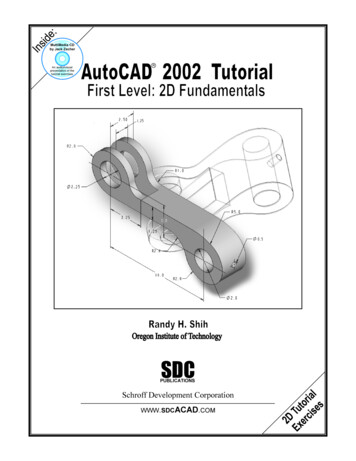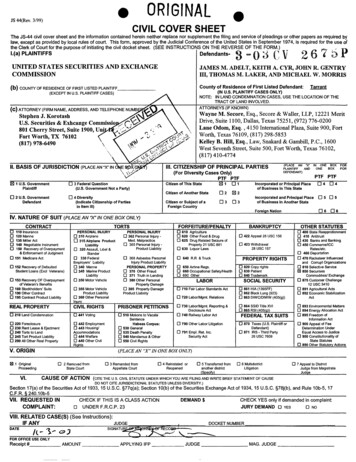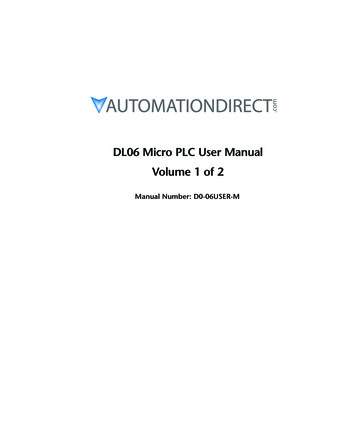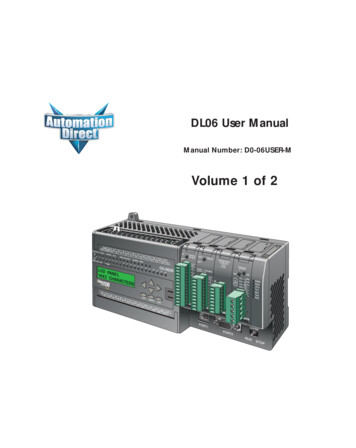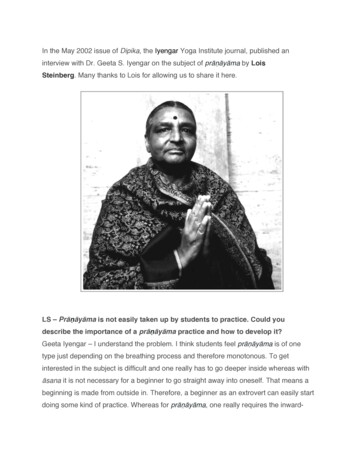
Transcription
In the May 2002 issue of Dipika, the Iyengar Yoga Institute journal, published aninterview with Dr. Geeta S. Iyengar on the subject of prāṇāyāma by LoisSteinberg. Many thanks to Lois for allowing us to share it here.LS – Prāṇāyāma is not easily taken up by students to practice. Could youdescribe the importance of a prāṇāyāma practice and how to develop it?Geeta Iyengar – I understand the problem. I think students feel prāṇāyāma is of onetype just depending on the breathing process and therefore monotonous. To getinterested in the subject is difficult and one really has to go deeper inside whereas withāsana it is not necessary for a beginner to go straight away into oneself. That means abeginning is made from outside in. Therefore, a beginner as an extrovert can easily startdoing some kind of practice. Whereas for prāṇāyāma, one really requires the inward-
going process. Not only does one have to become an extrovert, but one needs intravision. Patañjali very clearly indicated that prāṇāyāma a has to come after āsana isconquered. In the āsana there is a process of going from outside in. Making the body tounderstand, getting the sensitivity, the feeling of equilibrium, inner alignments, etc. Ifthat understanding comes, then the prāṇāyāma begins.The problem is that when students begin to do prāṇāyāma, they can’t see an immediateeffect of it. So, they feel that there is not feedback from the early stages of practice.Whereas from āsana there is an immediate feedback: you feel nice; you feel somethinggood happening in you; some life coming in you, blood getting circulated,feeling freshness of the mind; you feel that dullness is lessening. But in prāṇāyāmathese things cannot be felt immediately. It takes its own time.But still, sometime the beginning has to be made. So, if a beginner has to make anattempt towards it, first they have to learn to relax their body, relax their mind as we doin Śavāsana. Often, I feel that Śavāsana is a kind of threshold between āsana andpranayama. Once they begin to feel the relaxation in Śavāsana, students come closer totheir breath. The mind gets settled inside and the cellular body settles. Then they comeinto contact with their inner energy. And once they come to know their inner energy andthe breath then I think the interest in prāṇāyāma a will begin to grow like when you putthe seed into the soil – the sprouting has to occur at that stage.At this stage, one becomes better acquainted with that breath. If we just have someideas in our mind that breathing should be long, it should be very deep, it should becomplete, then we run into so many obstacles because of our way of thinking. It doesn’thappen. The breath won’t be deep; the breath won’t be long. To reach toward thoseidealistic views one has to approach it differently. And if that is understood, then I thinkone will gain interest into the practice of prāṇāyāma. First, a beginner has to learn to doŚavāsana a properly. And in Śavāsana, a beginner has to feel the movement of thebreath, the inhalation and exhalation. And then, while exposing that inhalation andexhalation you gain insight into the body’s intelligence. A beginner has to feel the lungs,the ribs, the intercostal muscles, the abdomen, the very positioning and the verymovement of it. What kind of inner expansion is occurring? How one is creating space
in inhalation. How one is getting quieted in exhalation. How the body is receding. If thiskind of dialogue with one’s own body and one’s own breath happens, I think a beginnerwill begin to get interested. But if you ask me for specific types of prāṇāyāma a, thenUjjāyi and Viloma will be helpful.LS – In terms of other practical aspects of prāṇāyāma practice, some people getconfused when to practice it in relation to āsana.Geeta Iyengar – It depends on how one has progressed in one’s practice. I would say abeginner always would prefer to do prāṇāyāma after āsana practice.LS – Even if it’s a strong āsana practice?Geeta Iyengar – After a strong āsana practice, you give extra time to Śavāsana andthen the prāṇāyāma can begin. It depends on how much time one has set aside forpractice. When you say strong āsana practice, let us suppose you have two hours topractice. One can divide that time. One and quarter hours, or one and a half hours ofāsana practice, ten minutes of Śavāsana and then twenty minutes of prāṇāyāma. Afteran āsana practice the body develops some intelligence, some understanding. Even ifthey have done some standing poses, some forward bends, or some backwardextensions or lateral twistings, some inversions like Śīrṣāsana and Sarvāṅgāsana. Thenwith this regular, normal, usual practice, they can certainly do prāṇāyāma for half anhour: ten minutes of Śavāsana, and then another five or ten minutes of Ujjāyi cycles,
watching their breath. By that time the body is relaxed and the nerves are quieted. Theimpression of the fatigue they had in their āsana practice will be removed in Śavāsana.Freshness in the body comes up. But intelligence doesn’t fade. What I mean byintelligence is, the nerve fibers get stimulated in the āsana practice; there is a feeling ofexhilaration and then with āsana-s such as Sarvāṅgāsana., Halāsana or Setubandhasarvāṅgāsana, the feeling of quietness comes to the nerves. That is a kind ofnourishment to the nerves required for prāṇāyāma practice. So, if that nourishmentcomes from the āsana practice, then prāṇāyāma becomes easier. These āsana-s areconducive to take one’s attention inwards to feel the body, the breath and the mind.They pacify the ego and bring humbleness.Sometimes your breath will be just normal and then suddenly you find your exhalation isbecoming further, longer. It’s becoming somehow deep. So, watch that. Observe that.Sometimes you find your inhalation is becoming deeper than normal. So how can thiskind of progress occur in the inhalation and the exhalation? We begin to trace how theinhalation is happening. How the exhalation is happening. A kind of understanding andawareness comes. At that point, the question is not whether what comes is correct orwrong, but it is a question of whether the sensitivity has come, whether you understandthat there is some difference between inhalation and exhalation, there are somechanges, occurring at a certain stage or not. Even if they begin to watch only that, Ithink they are gradually beginning to proceed toward the prāṇāyāma practice. So, if thatnourishment comes from the āsana practice, then pr. One has to identify and notifywhat is happening within, with the body, mind and breath.For well-advanced students, this question doesn’t arise. When you have got the feelingof prāṇāyāma, then you prefer to give a separate time for it. Because then you cannotjust finish in a hurry. Then that student feels from inside that prāṇāyāma practice has tobe separated from āsana practice in order to get the proper effect. Let us say ifprāṇāyāma is done for forty-five minutes or one hour, then obviously it cannot be joinedwith the āsana practice. Most pupils will not have the time for a long āsana practice andthen a long prāṇāyāma practice. But you as senior pupils want to watch yourprāṇāyāma. You want to learn something. You want to consolidate what you have
learned. Then you need more time, longer duration. But as a beginner, I may suggestthat instead of a full prāṇāyāma practice one can just lie down in Śavāsana and dosome cycles of breath, watching the movement of the chest since it can be felt by oneand all.LS – Since we are talking about prāṇāyāma, could you talk about the significanceof Hanumān (Monkey God) to yoga?Geeta Iyengar – Actually, Hanumān is called Praṇā Dev. He’s the Lord of Praṇā. And itis said that all the five Praṇā-s are existing in him with full potency: Praṇā, Apāna,Samāna, Udāna and Vyāna. That means that Lord Hanumān has control over all thesefive Praṇā. And through this control he has certain Siddhis (supernatural powers). In thetale of Rāmāyaṇam, Hanumān really showed these qualities Hanumān was also a goodmusician. He was also a practitioner of yoga. And to some extent he was a Praṇā toRāma, if Rāma was the soul. You see, we say the soul is the inner potency that wehave, Dṛṣṭa. And this Dṛṣṭa has to be served by Dṛśya – the (The Seer). That’s whatPatañjali’s Yoga Sūtra-s say. Rama is considered to be the Puruṣha and Sita is thePrakrti. Hanumān is the Prāṇa because the connection between the Prakṛti and thePuruṣha is only on the path of Prāṇa – the cosmic energy, the cosmic intelligence.Prāṇa is not just the breath but the energy. And breathing is the process by which youapply that energy to find out how deep that energy penetrates and percolates, howdivine that energy is, how much purification of that energy is possible. How you canreally explore that energy. We have hidden energy inside. The energy has to come up.It also serves the Puruṣha in different ways. And that is what Patañjali’s Yoga Sutras
say – in the Vibhūti pādaḥ – that you can get control over the different channels ofenergy. They are connected with the five elements and unless the Prāṇa unites thesefive elements, the nectar from the five elements won’t come up. Each element has gotits own strength, its own energy. When Prāṇa gets united, this energy comes upward.That is how Hanumān served Rama and Sita, Puruṣha and Prakṛti, through his energy,through his own potency.LS – Pranayama has saved my life, twice. When I couldn’t do anything else, I hadpranayama.Geeta Iyengar – It heals. Because you get some control over these senses ofperception, the organs of action and through those, the body, of course. Prāṇāyāmastrengthens the nervous system. You begin to feel how the nerves are carrying theenergy. Even if people do not know anything, if they begin from Śavāsana and in thatŚavāsana watch their breath, it will enact that healing process.We have so many varieties of prāṇāyāma. There is Anuloma prāṇāyāma, Pratilomaprāṇāyāma, or Viloma prāṇāyāma, and whichever you take they all have stages. Whatare these stages? Prāṇāyāma develops from stage I gradually. It’s like a flowerblooming. The first cycle will not come at once. It will remain in a seed form somewhere.Guruji begins from that seed form in stage I and stage II. Then the flower bloomscompletely at higher stages. That means the stages of prāṇāyāma gradually develop tothat level and you begin to understand what’s happening. It is a very safe process. Youwould be surprised that Guruji doesn’t introduce Bandha-s (locks) until a certain stage.He goes very slowly. Then, as you proceed, the Bandha-s begin to come to you. Youfeel it yourself. And from that you develop.LS – Yes this state happened. How did it happen?Geeta Iyengar – For example, simple Jālandharabandha. You do a few cycles of Ujjāyi;a time comes when the head begins to go down. There is a period where the headdoesn’t come down. You don’t get a proper position. The throat has to sort of create the
space; it doesn’t come with a chin lock. So first the chin-locking process is physical. Butthen when you find something is happening in the inner walls of the throat. Also, yourhead is getting quieted. Your brain cells are getting quieted. Your senses of perceptionare getting quieted. Then the head comes down further. The more you become humbleand quiet, the better Jālandharabandha comes. That means the natural way ofJālandharabandha is occurring. But the pain elements – the neck pain, muscular pain orstrain come later, after ten, twelve, or fifteen cycles. That means you have crossed yourlimit. You may come to a boundary line where the neck is paining. But Guruji says not togo right up to where the neck pain comes in Jalandhara Bandha. If you are not gettingthe chin-lock use a bandage. So, you are so safe, you are not holding your throat tight.You are not jamming anything inside. Because he has given those safety measures, Idon’t think anybody should feel afraid to practice prāṇāyāma.The improvement in the techniques as one begins to understand the depth ofprāṇāyāma is quite different to that of the understanding of a beginner. A beginner hasto stick to a program or a format very strictly. He/she may do Ujjāyi or Viloma cycles, buthas to stick to that practice. With this regimented program one gradually begins to getsensitivity. The breath cycles may go mechanically, but the mechanical breathing cyclestell you, “Oh! This is not the way. Let me slow down and observe.” This is sensitivity.You begin to learn what needs to be unlearned. The unlearning process further leadsyou to say what has to be learned. This is the way to educate oneself.
In the May 2002 issue of Dipika, the Iyengar Yoga Institute journal, published an interview with Dr. Geeta S. Iyengar on the subject of prāṇāyāma by Lois Steinberg.Many thanks to Lois for all



